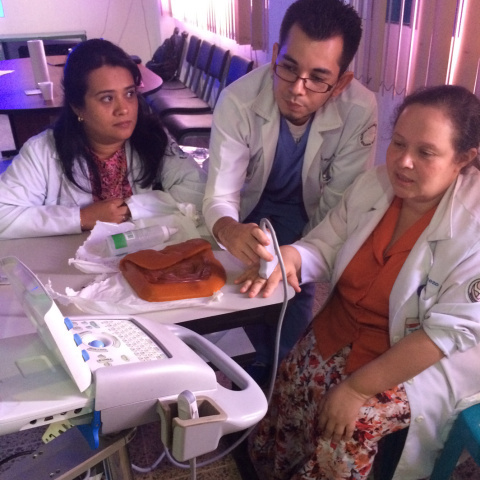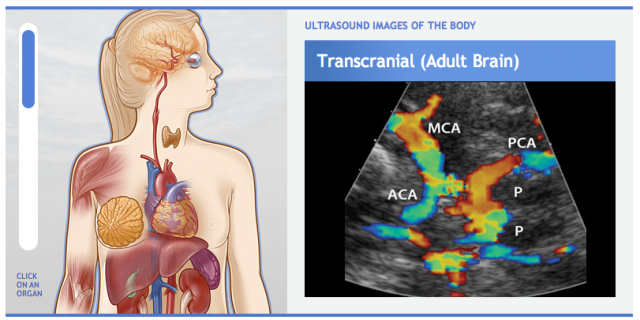Better Peek Inside
Herald Net | August 8, 2005
“Sonosite’s portable ultrasound machines have helped doctors from Seattle emergency rooms to field hospitals in Iraq quickly find internal injuries.”
Note: Link no longer available from original site …
Power in a Small Package
RT image | August 8, 2005
“Sonosite Inc. announces the worldwide launch of its MicroMaxx ultrasound system, the company’s third generation hand-carried product.” Read full article …
The Sonosite MicroMaxx
MedGadget | April 20, 2005
“Sonosite, Inc. has announced the release of its latest, laptop size ultrasound system.” Read full article …
On Sonosite’s Screen
Business Week | March 14, 2005
“There are few CEOs like Kevin Goodwin, who boasts that his company leaves General Electric in the dust. Sonosite is way ahead of GE — in handheld products for ultrasound imaging.” Read full article …
Shake ‘Em Up
Forbes | February 14, 2005
“Kevin Goodwin has a cheap handheld ultrasound device. Can he take down GE and Siemens?”
Note: Link no longer available from original site
…
Global Health: Teaching Ultrasound in El Salvador

It is sometimes easy to forget how privileged we are to have access to modern conveniences, healthcare technologies and services. Fortunately, at Sonosite, we enjoy supporting many adventurous care providers who share their skills in resource limited countries. One such Doctor is Dr Jennifer Chao. Upon her return from El Salvador we received this informative email:
…
Global Health: Teaching ultrasound in Malawi - Dr Bergman

Global Health is more than providing medical care in resource limited countries. To create sustainable global health, four physicians from Contra Costa Family Medicine residency traveled to Malawi to do an ultrasound training for Malawian clinicians. They were kind enough to send us lots of photos and the following summary: …
Fujifilm Sonosite Explores the Future of Visual Medicine at HIMSS 2014 Annual Conference and Exhibition
The Future LIVE and Visualized at #HIMSS14
HIMSS14 is a global, cause-based, not-for-profit organization focused on better health through information technology (IT). This year's HIMSS conference, hosted in Orlando, Florida, is a huge exhibition with the latest in medical technology. …
Sonosite Teams up with the Seattle Seahawks 2014 Super Bowl Champions
Proin commodo at justo ac sagittis.
Duis felis odio, mattis nec nibh eget, vestibulum semper metus. Nullam semper eget mauris sit amet vulputate. In hac habitasse platea dictumst. Vestibulum et semper risus. Mauris porta eleifend enim. Donec rhoncus orci ut diam adipiscing mollis. Donec at gravida enim. Aenean viverra, augue molestie rutrum suscipit, neque orci pharetra ligula, non tristique magna nulla eu mauris. Nullam pretium, tellus quis luctus tempor, est sem aliquet dui, et feugiat neque nisl in nunc. …
mHealthSummit 2014
mHealthSummit 2014, Washington, D.C.
The largest event of its kind, the 5th annual mHealth Summit brings together leaders in government, the private sector, industry, academia, providers and not-for-profit organizations from across the mHealth ecosystem to advance collaboration in the use of wireless technology and to improve health outcomes in the United States and abroad.
Deep connections are made at mHealthSummit. …
From the front lines... Code Black Movie
About Code Black Movie
In his vivid and thought-provoking filmmaking debut, physician Ryan McGarry gives us unprecedented access to America’s busiest Emergency Department. …
What if you could reduce door-to-balloon time for heart attack patients?
Read More from the Experts
PUBMED.gov | 2013 Jul-Sep;17
EMS activation of the cardiac catheterization laboratory is associated with process improvements in the care of myocardial infarction patients
PUBMED.gov | 2010 Apr-Jun
Early cardia …
Interview with Chanel Fishetti - Glimps Show by Fujifilm Sonosite
Chanel Fischetti @Chanel_Fischetti
Chanel Fischetti grew up in Southern California and attended the University of Southern California in Los Angeles where she ran track and cross country. She is currently attending medical school at the University of California Irvine and plans to practice in the field of emergency medicine with a special focus in ultrasound and international health. Outside of medicine, Chanel loves to run, spend time with friends and family and work with the special needs community. …
Dr. Liz Turner discusses Visual Medicine on Sonosite's GLIMPSE show
Lorem ipsum dolor sit amet, consectetur adipiscing elit. Vivamus fringilla mollis varius. Proin est tellus, congue eu sagittis id, suscipit eget mi. Phasellus non ligula vel erat facilisis adipiscing at et ligula. Maecenas eu nisl at magna egestas vestibulum. Fusce ligula leo, hendrerit convallis nibh ac, lobortis vulputate diam. Nullam gravida ac leo nec interdum. Vivamus quis neque quis ligula ultrices euismod. Nulla interdum, lacus luctus rhoncus euismod, velit augue tristique mi, vehicula tristique sem dolor nec lectus. Pellentesque non convallis ipsum. …
Dr. Byron Patterson, Discusses Visual Medicine on Sonosites GLIMPSE Show
Lorem ipsum dolor sit amet, consectetur adipiscing elit. Vivamus fringilla mollis varius. Proin est tellus, congue eu sagittis id, suscipit eget mi. Phasellus non ligula vel erat facilisis adipiscing at et ligula. Maecenas eu nisl at magna egestas vestibulum. Fusce ligula leo, hendrerit convallis nibh ac, lobortis vulputate diam. Nullam gravida ac leo nec interdum. Vivamus quis neque quis ligula ultrices euismod. …
Dr. Francis Yamazaki, Discusses Anesthesia on Sonosite's GLIMPSE Show
Lorem ipsum dolor sit amet, consectetur adipiscing elit. Vivamus fringilla mollis varius. Proin est tellus, congue eu sagittis id, suscipit eget mi. Phasellus non ligula vel erat facilisis adipiscing at et ligula. Maecenas eu nisl at magna egestas vestibulum. Fusce ligula leo, hendrerit convallis nibh ac, lobortis vulputate diam. Nullam gravida ac leo nec interdum. Vivamus quis neque quis ligula ultrices euismod. …
Dr. John Christian Fox and Joel Shlang discuss Medical Education, Sonosite's GLIMPSE Show
Lorem ipsum dolor sit amet, consectetur adipiscing elit. Vivamus fringilla mollis varius. Proin est tellus, congue eu sagittis id, suscipit eget mi. Phasellus non ligula vel erat facilisis adipiscing at et ligula. Maecenas eu nisl at magna egestas vestibulum. Fusce ligula leo, hendrerit convallis nibh ac, lobortis vulputate diam. Nullam gravida ac leo nec interdum. Vivamus quis neque quis ligula ultrices euismod. Nulla interdum, lacus luctus rhoncus euismod, velit augue tristique mi, vehicula tristique sem dolor nec lectus. Pellentesque non convallis ipsum. …
Ultrafest UCI 2014 Highlight Film

Ultrafest Ultrasound Festival hosted at UCI (University of California, Irvine) 2014
…
Visit AIUM's Ultrasound in Medical Education Interest Group

The site features an ultrasound interactive graphic. AIUM’s Ultrasound in Medical Education Interest Group collaborative portal is intended to be a clearinghouse of resources related to facilitating the integration of ultrasound into medical school education. …

